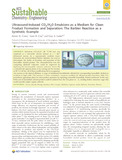JavaScript is disabled for your browser. Some features of this site may not work without it.
| dc.contributor.author | Cenci, Steven M. | |
| dc.contributor.author | Cox, Liam R. | |
| dc.contributor.author | Leeke, Gary A. | |
| dc.date.accessioned | 2016-10-19T14:17:42Z | |
| dc.date.available | 2016-10-19T14:17:42Z | |
| dc.date.issued | 2014-04-03 | |
| dc.identifier.citation | Cenci, S. M., Cox, L. R., Leeke, G. A. (2014) Ultrasound-induced CO2/H2O emulsions as a medium for clean product formation and separation: The barbier reaction as a synthetic example, ACS Sustainable Chemistry and Engineering, Vol. 2, Iss. 5, pp. 1280 - 1288 | en_UK |
| dc.identifier.issn | 2168-0485 | |
| dc.identifier.uri | http://dx.doi.org/10.1021/sc500112q | |
| dc.identifier.uri | http://dspace.lib.cranfield.ac.uk/handle/1826/10786 | |
| dc.description.abstract | : Subcritical CO2/H2O (30 °C/80 bar) was employed as a renewable solvent mixture in a 1 dm3 ultrasound reactor. As a representative synthetic transformation, the metal-mediated Barbier allylation was used to demonstrate the facility of formation and separation of the homoallylic alcohol product. The chemoselectivity over the competing aldehyde reduction could be improved by deploying the biocompatible nonionic surfactant Tween 80, a saturated salt aqueous phase, or by carrying out the reaction at 60 °C/120 bar. All of these modifications led to an apparent rate increase in the desired allylation. A range of substituted benzaldehydes afforded the corresponding homoallylic alcohols in moderate to high yields. The presence of water constituted a necessary condition for efficient product formation, while CO2 provided an appropriate phase for clean product separation by exploiting a favorable homoallylic alcohol enrichment. In this way, 0.025 mol of homoallylic alcohol product could be isolated from the CO2 phase in 1 h, avoiding further extraction stages that would typically require organic solvents. | en_UK |
| dc.language.iso | en | en_UK |
| dc.publisher | American Chemical Society | en_UK |
| dc.rights | Attribution 4.0 International (CC BY 4.0) You are free to: Share — copy and redistribute the material in any medium or format, Adapt — remix, transform, and build upon the material for any purpose, even commercially. The licensor cannot revoke these freedoms as long as you follow the license terms. Under the following terms: Attribution — You must give appropriate credit, provide a link to the license, and indicate if changes were made. You may do so in any reasonable manner, but not in any way that suggests the licensor endorses you or your use. Information: No additional restrictions — You may not apply legal terms or technological measures that legally restrict others from doing anything the license permits. | en_UK |
| dc.subject | Carbon dioxide | en_UK |
| dc.subject | Mixing | en_UK |
| dc.subject | Emulsion | en_UK |
| dc.subject | Mass transfer | en_UK |
| dc.subject | Allylation | en_UK |
| dc.subject | Aqueous media | en_UK |
| dc.subject | Biphasic | en_UK |
| dc.subject | Sonication | en_UK |
| dc.subject | Kinetics | en_UK |
| dc.title | Ultrasound-induced CO2/H2O emulsions as a medium for clean product formation and separation: The barbier reaction as a synthetic example | en_UK |
| dc.type | Article | en_UK |
Files in this item
This item appears in the following Collection(s)
-
Staff publications (SWEE) [2880]
